FREE Samples
Our approach:
5W1H Mindmap: We arrange mindmap nodes using 5W (What, Why, Where, When, Who) & 1H (How) approach to help you in learning a concept quickly and leaving no stones unturned as you can answer any questions that may be asked from the topic with this approach.
Concept Image: Captures the essence of the topic so that you can remember & recall concepts better. For example, take a look at image in similipal kai chutney topic below as it captures the essence of the topic such as the red ants, garlic, tomato, tribal attire, surrounding environment, etc.
Single paragraph summary: For quick grasp of the issue in the first-reading.
[Newsbits] 5.01.2024: Similipal Kai Chutney, GSAT-20, Wetland City Tag & more
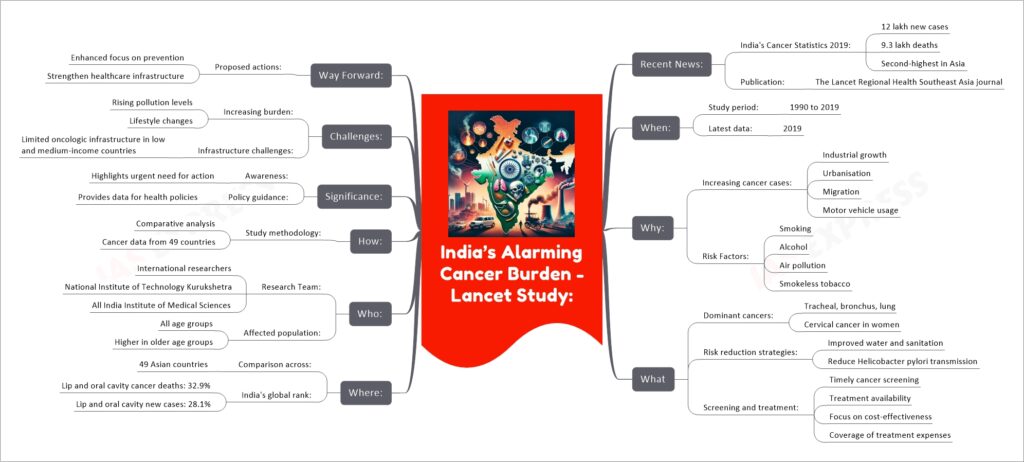
This mindmap outlines the key aspects of India’s alarming cancer burden as highlighted by a recent Lancet study. The study, which analyzed data from 1990 to 2019, reveals that India recorded approximately 1.2 million new cancer cases and 930,000 deaths in 2019, ranking second in Asia in terms of the cancer burden. The study sheds light on the dominant types of cancer, key risk factors, and the need for timely cancer screening and treatment, especially in low and medium-income countries. It also emphasizes the role of industrial growth, urbanization, migration, and motor vehicle usage in the rising cancer cases, highlighting the importance of addressing these factors to mitigate the increasing cancer burden.
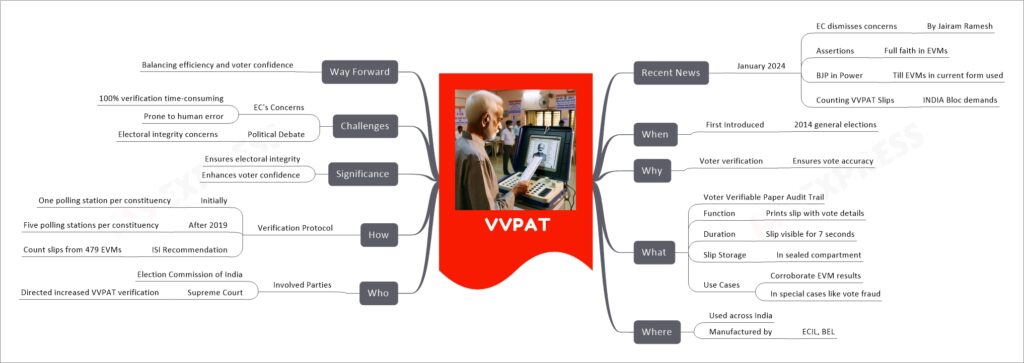
Voter Verifiable Paper Audit Trail (VVPAT) is a system used in Indian elections to enhance the transparency and reliability of the voting process. Introduced in 2014, VVPAT machines print a slip with the voter’s choice, allowing them to verify their vote before the slip is securely stored. This mechanism serves to corroborate results from Electronic Voting Machines (EVMs), especially in cases of alleged vote fraud. Recently, there have been discussions and proposals for changes in VVPAT use, including a proposal for 100% counting of slips to enhance trust in elections. While the Election Commission of India maintains faith in the current protocol, which involves verifying VVPAT slips from five polling stations per constituency, there is an ongoing debate about electoral integrity and the challenges of balancing efficiency with voter confidence.
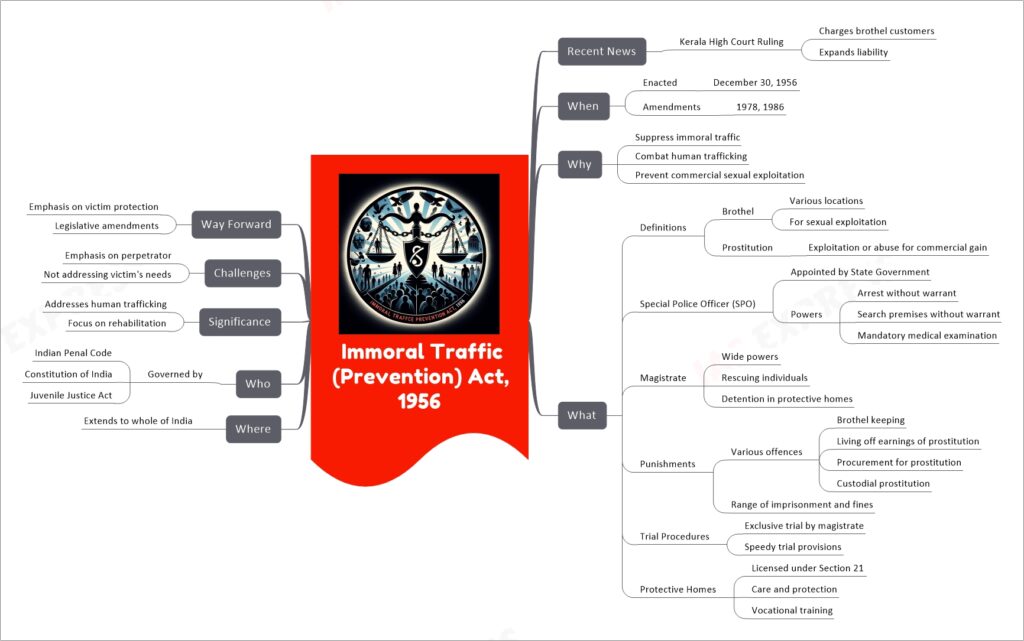
The Immoral Traffic (Prevention) Act of 1956, commonly known as ITPA, is an Indian legislation initially enacted to combat the trafficking of women and children for the purpose of prostitution. This act, which aligns with international conventions, doesn’t criminalize prostitution per se but targets activities like brothel keeping, pimping, and procuring individuals for prostitution. With provisions for the rescue and rehabilitation of victims, the Act empowers special police officers and magistrates to enforce its provisions. However, it has faced criticism for focusing more on the perpetrators rather than adequately addressing the needs of the victims. Recent legal interpretations, such as the Kerala High Court’s decision to charge brothel customers, demonstrate evolving judicial attitudes towards this complex issue.

Nano urea, a nanotechnology-based fertilizer, is an innovative product introduced in India to enhance agricultural productivity while being environmentally friendly. It is designed to release nutrients in a controlled manner, offering higher efficiency and cost-effectiveness compared to conventional urea. The Indian government has been promoting nano urea to reduce dependence on traditional fertilizers, aiming for self-sufficiency in urea production by 2025-26. Despite its benefits, recent field studies by Punjab Agricultural University have shown a decrease in crop yields (rice and wheat), posing a challenge to its efficacy. The government plans to expand production facilities and further research is needed to address these yield concerns.
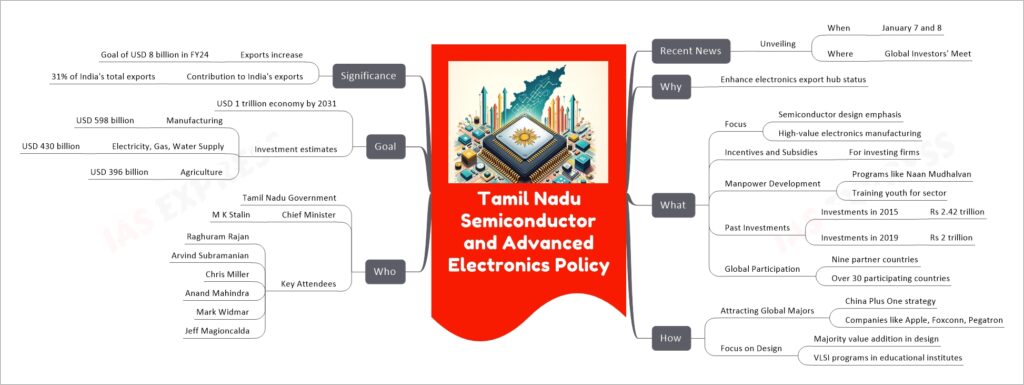
Tamil Nadu’s Semiconductor and Advanced Electronics Policy is a strategic initiative set to be unveiled at the Global Investors’ Meet on January 7 and 8. The policy aims to boost Tamil Nadu’s status as a major electronics export hub in India, with a strong emphasis on semiconductor design and high-value electronics manufacturing. The government anticipates record investments and has plans for incentives and subsidies to attract firms. This policy is part of Tamil Nadu’s larger goal to become a USD 1 trillion economy by 2031, with substantial investments in various sectors.
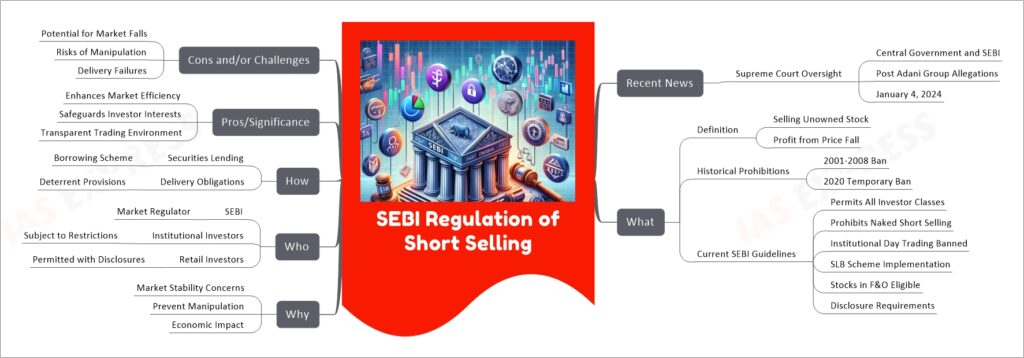
The Indian Government, through the Securities and Exchange Board of India (SEBI), has implemented a comprehensive framework to regulate short selling in the securities market. Short selling involves selling a stock that the seller doesn’t own at the time of the trade, aiming to profit from a price drop. SEBI’s recent guidelines permit all classes of investors to engage in short selling, strictly prohibiting naked short selling. Institutional investors face restrictions like the ban on day trading and are required to declare their short sales. The Securities Lending and Borrowing (SLB) scheme supports this practice. These measures aim to enhance market efficiency, protect investor interests, and maintain a transparent and secure trading environment.
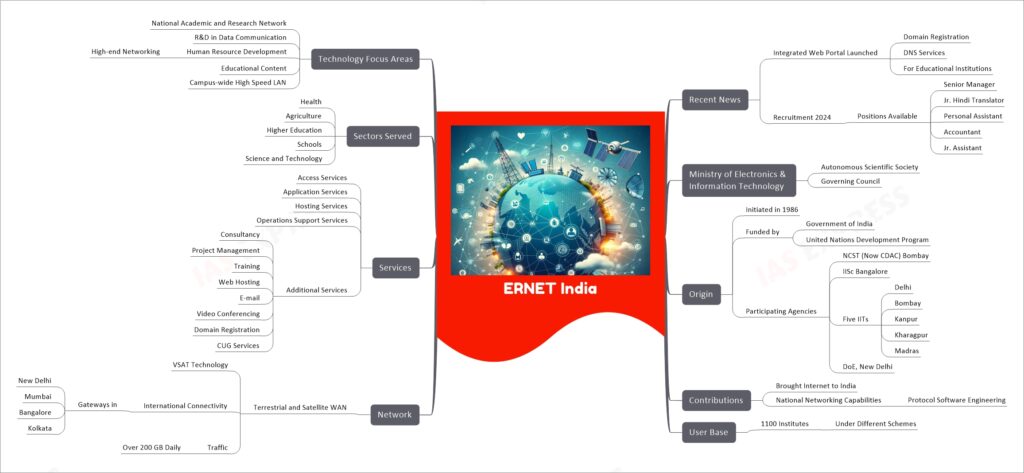
ERNET India, an autonomous scientific society under the Ministry of Electronics & Information Technology, plays a pivotal role in India’s digital landscape. It was established in 1986 with joint funding from the Government of India and the United Nations Development Program, and it involves top academic institutions like IISc Bangalore and the IITs. ERNET India was instrumental in introducing the Internet to the country and has since developed a sophisticated terrestrial and satellite network to support its vast user base of over 1100 institutes. The organization is not just about providing connectivity; it also offers a range of services like web hosting, e-mail, video conferencing, domain registration, and other IT and ICT services, catering to sectors like health, agriculture, education, and science & technology. Recently, they launched an integrated web portal for educational institutions and announced their 2024 recruitment.

NewSpace India Limited (NSIL), established on March 6, 2019, under India’s Department of Space, serves as the commercial arm of the Indian Space Research Organisation (ISRO). Its primary role is to enhance private sector involvement in India’s space programs. NSIL is currently preparing for the GSAT-20 mission, scheduled for the second quarter of 2024, in collaboration with SpaceX using the Falcon-9 rocket. The company’s functions encompass producing and assembling launch vehicles, offering satellite services across various spectrums, and contributing to building satellites for diverse applications. NSIL is central to scaling up India’s technological capabilities in the space sector, emphasizing industry participation and global service provision.
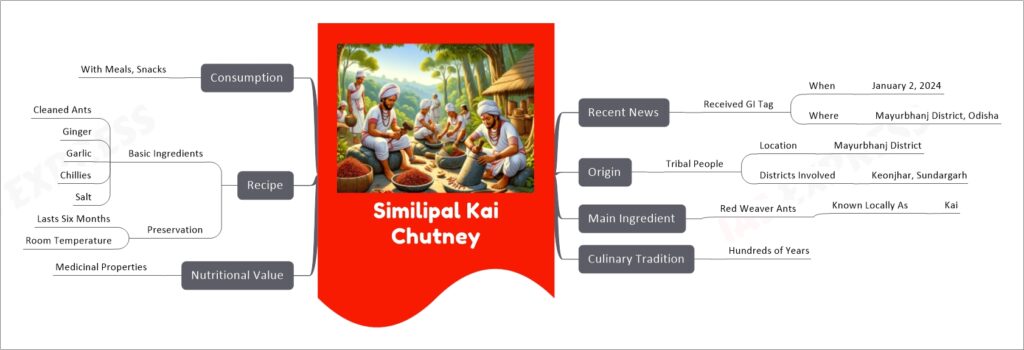
Similipal Kai Chutney is a traditional delicacy from the tribal regions of Odisha’s Mayurbhanj district, primarily made from red weaver ants known locally as ‘Kai’. This unique chutney, part of the culinary heritage for hundreds of years, received a Geographical Indication (GI) tag on January 2, 2024. The chutney, celebrated for its medicinal properties and nutritional value, typically includes ingredients like ginger, garlic, chillies, and salt. It’s noted for its long shelf life, lasting up to six months at room temperature, and is commonly consumed with meals and snacks.
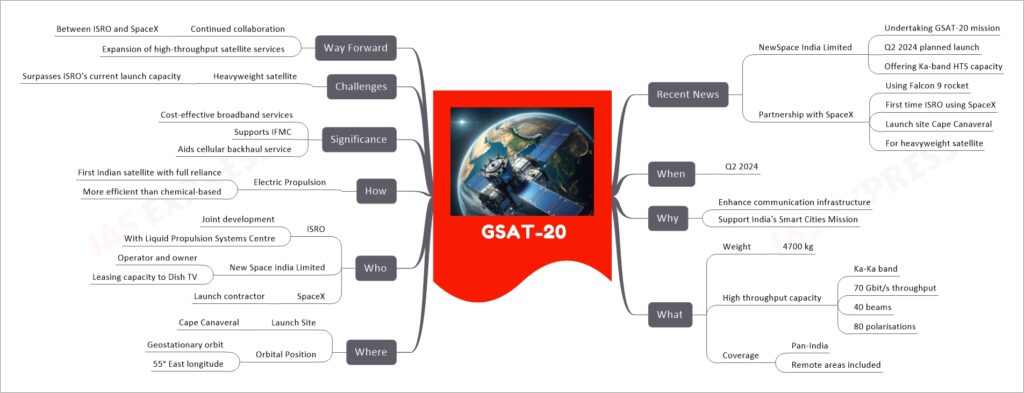
The GSAT-20 satellite, scheduled for launch in the second quarter of 2024, represents a significant advancement in India’s space capabilities. Operated by NewSpace India Limited and developed jointly by the Indian Space Research Organisation (ISRO) and the Liquid Propulsion Systems Centre, this mission marks the first time ISRO is partnering with SpaceX, using their Falcon 9 rocket. The GSAT-20, weighing 4,700 kg and employing electric propulsion, is designed to enhance India’s communication infrastructure, particularly supporting the Smart Cities Mission. It features a high-throughput Ka-band communications payload, capable of delivering 70 Gbit/s throughput across 40 beams, effectively creating 80 polarizations for extensive coverage, including remote areas of India. This mission underscores India’s commitment to advancing its satellite communication technology while addressing challenges such as the satellite’s heavyweight.
Climate Change: Causes, Impacts on India & World
What is climate change?
- Climate Change is a periodic modification of Earth’s climate brought about due to the changes in the atmosphere as well as the interactions between the atmosphere and various other geological, chemical, biological and geographical factors within the Earth’s system.
- Climate change can make weather patterns less predictable. These unforeseen weather patterns can make it difficult to maintain and grow crops, making agriculture-dependent countries like India vulnerable.
- It is also causing damaging weather events like more frequent and intense hurricanes, floods, cyclones, flooding etc.
- Due to the rising temperature caused by climate change, the ice in the polar regions is melting at an accelerated rate, causing sea levels to rise. This is damaging the coastlines due to the increased flooding and erosion.
- The cause of the current rapid climate change is due to human activities and threatening the very survival of humankind.

What are the factors that cause climate change?
Climate change is caused by natural factors as well as anthropogenic factors. However, anthropogenic factors create a higher impact on contemporary climate change.
Natural Factors:
There are numerous natural factors that cause the Earth’s climate to change. They affect the climate over a period of thousands to millions of years.
Continental Drift:
- The present-day continents were not the same prior to 200 million years.
- They have formed millions of years ago when the landmass began to drift apart due to plate displacement.
- This movement had an impact on climate change due to the change on the landmass’s physical features and position and the change in water bodies’ position like the change in the follow of ocean currents and winds.
- The drifting of the landmass is continued today. The Himalayan range is rising approximately 1 millimetre every year as the Indian landmass is moving towards the Asian landmass.
Variation of the Earth’s orbit:
- The Earth’s orbit has an impact on the sunlight’s seasonal distribution that is reaching the Earth’s surface.
- A slight change in the Earth’s orbit can lead to variation in distribution across the world.
- There are very few changes to the average sunshine. However, it causes a high impact on the geographical and seasonal distribution.
- There are three types of orbital variations – variations in Earth’s eccentricity, variations in the tilt angle of the Earth’s axis of rotation and precession of Earth’s axis.
- These together can cause Milankovitch cycles, which have a huge impact on climate and are well-known for their connection to the glacial and interglacial periods.
- The Intergovernmental Panel on Climate Change finding showed that the Milankovitch cycles had influenced the behaviour of ice formation
Plate tectonics:
- Due to the change in the temperature in the core of the Earth, the mantle plumes and convection currents forced the Earth’s Plates to adjust leading to the rearrangement of the Earth Plate.
- This can influence the global and local patterns of climate and atmosphere.
- The oceans’ geometry is determined by the continents’ position. Therefore, the position of the continents influences the pattern of the ocean.
- The location of the sea also plays a crucial role in controlling the transfer of heat and moisture across the globe and determines the global climate.
- The recent example of the tectonic control on ocean circulation is the formation of the Isthmus of Panama about 5 million years ago, leading to the prevention of direct mixing of the Atlantic and Pacific oceans.
Volcanic Activity:
- When a volcano erupts, it emits gases and dust particles, causing a partial block of the Sunrays. This can lead to the cooling of the weather.
- Though the volcanic activities last only for a few days, the gases and ashes released by it can last for a long period, leading to it influencing climate patterns.
- Sulphur oxide emitted by the volcanic activities can combine with water to form tiny droplets of sulphuric acid. These droplets are so small that many of them can stay in the air for several years.
Ocean Currents:
- Ocean current is one of the major components of the climate system.
- It is driven by horizontal winds causing the movement of the water against the sea surface.
- The temperature differences of the water influence the climate of the region.
Anthropogenic Factors:
Scientists, since the beginning of the 20th century, have studied the impact of climate change caused by human activities. Global warming, the long-term rise in the average temperature of the Earth’s climate system, is a major aspect of climate change. It is mainly a human-caused increase in global surface temperature. The anthropogenic factors causing climate change are as follows:
Greenhouse Gases:
- The greenhouse gases absorb heat radiation from the sun. Following the initiation of the Industrial Revolution, the emission of greenhouse gases into the atmosphere has increased exponentially.
- This has led to more absorption and retaining the heat in the atmosphere. This resulted in an increase in Global Temperature.
- The greenhouse gases mostly do not absorb the solar radiation but absorb most of the infrared emitted by the Earth’s surface.
- The main greenhouse gases include
- water vapour (the majority of the GHG in the atmosphere but the impact is less)
- Carbon dioxide released due to natural and anthropogenic factors spends more time in the atmosphere, leading to an increase in its impact. There has been a 30% increase in the concentration of CO2 since the start of the industrial revolution. Apart from the industrial revolution, deforestation also contributes to the increase in the CO
- Chlorofluorocarbons, used for industrial purposes, especially in refrigerants and air conditioning, is a man-made compound regulated under the Montreal Protocol due to their adverse effects on the Ozone layers.
- Methane is released due to decomposition of organic matter. It is stronger than CO2 because of its capacity to absorb more heat.
- Nitrous oxide is produced by the agricultural sector, especially in the production and use of organic fertilizers and while burning fossil fuels.
Change in the land use pattern:
- Half of the land-use change is said to have happened during the industrial era.
- Most of the forests were replaced by agricultural cropping and grazing of lands.
- The increased albedo (reflectivity of an object in space) in the snow-covered high altitude regions due to deforestation led to the cooling of the planet’s surface. The lower the albedo, the more of the Sun’s radiation gets absorbed by the planet and the temperatures will rise. If the albedo is higher and the Earth is more reflective, the more of the radiation is returned to space, leading to the cooling of the planet.
- The tropical deforestation changes the evapotranspiration rates (the amount of water vapour put in the atmosphere through evaporation and transpiration from trees), causes desertification and affects soil moisture characteristics.
- From the satellite imagery, it is seen that the clearing of forest cover for agriculture and irrigated farming in arid and semi-arid lands can increase solar energy absorption and the amount of moisture evaporated into the atmosphere.
Atmospheric aerosols:
- Atmospheric aerosol can:
- scatter and absorb the solar and infrared radiation
- change microphysical and chemical properties of the clouds
- Solar radiation, when scattered, cools the planet. On the other hand, when the aerosols absorb solar radiation, it causes an increase in the temperature of the air instead of allowing the sunlight to be absorbed by the Earth’s surface.
- Aerosols can directly affect climate change by absorbing or reflecting solar radiation. They can also produce indirect effects by modifying the cloud’s formation and properties.
- They can even be transported thousands of kilometres away from its source through wind and upper-level circulation in the atmosphere.
- There are two types of aerosols – Natural aerosols and Anthropogenic aerosols.
- The sources of natural aerosols include volcanic eruptions (produces sulphate aerosols) and biogenic sources like planktons (can produce dimethyl sulphide).
- The anthropogenic aerosols include:
- The ammonia used for fertilizers or released by the burning of plants and other organic materials forms a major source for Nitrate aerosols.
- Burning of coal and oil produces sulphur dioxide that forms a major source of sulphate aerosols
- Burning of biomass can release a combination of organic droplets and soot particles.
- Industrial activities cause the release of wide-ranging aerosols into the atmosphere.
- Vehicle emissions can produce numerous pollutants that are aerosol from the beginning or becomes one due to chemical reactions in the atmosphere.
- It is found that the concentration of aerosols is about three times higher in the Northern Hemisphere than in the Southern Hemisphere, leading to Northern Hemisphere’s radiation concentration being 50% higher than that of the Southern Hemisphere.
What are the effects of climate change?
Global warming has caused a change in the climatic and weather conditions like change in the rainfall pattern, increased flooding, drought, heatwaves, etc. The planet’s ocean and glaciers have felt some significant changes. Oceans are currently warming and becoming more acidic. The ice caps are melting, causing the sea levels to rise. These changes are predicted to be more prominent in the coming decades, threatening our environment and existence. Some of the current impacts of rapid climate change are as follows:
A rise in atmospheric temperature:
- The greenhouse gases released due to human activities are increasing the temperature of the Earth.
- The last 6 years topped the list of hottest years ever recorded.
- The increase in temperature is the major cause of the current increase in heat-related deaths and illnesses, rise in sea levels and an increase in the intensity of natural disasters.
- The 20th century saw an increase in the Earth’s average temperature by 1°F. This is believed to be the fastest rise in a thousand years.
- Research estimates predict that if the GHGs are not reduced, the average surface temperature could increase to 3-5°F by the end of this century.
Change in landscapes:
- Increasing temperature and changing climate and weather patterns across the globe led to the shift of trees and plants towards Polar Regions and mountains.
- As the vegetation tries to adapt to climate change by moving towards colder regions, the animals that are dependent on them will be forced to follow them for survival. While some survive, many perish in the attempt.
- Other species like polar bears dependent on cold terrains will not have any habitat due to the melting of ice, causing a risk to their survival.
- Thus, the current hasty change in the landscape causes a considerable risk to the survival of many species, including the human population.
A risk to the ecosystem:
- An increase in the temperature across the globe is changing the weather and vegetation patterns, making the species to migrate to cooler areas for survival.
- This poses a threat to the survival of numerous species. It is projected that by 2050, one-fourth of the Earth’s species may become extinct if the current trend continues.
Rising sea levels:
- An increase in the temperature of the Earth leads to a rise in sea level due to the thermal expansion (a condition wherein the warm water takes up more area than cooler water). The melting of glaciers adds to this problem.
- The population living in under-lying areas, islands and coasts are threatened by the rising sea levels.
- It erodes shorelines, damage properties and destroys ecosystems like mangroves and wetlands that protect coasts from storms.
- In the last 100 years, the sea level has risen to 4-8 inches and will continue to rise between 4 and 36 inches in the next 100 years.
Ocean Acidification:
- The increase in the CO2 concentration in the atmosphere has increased the CO2 absorption in the ocean. This makes the ocean acidic.
- The increase in the acidification of the ocean can be harmful to many marine species like plankton, molluscs, etc. The corals are especially susceptible to this as they find it difficult to create and maintain the skeletal structures needed for their survival.
Increase in the risk of natural and manmade disasters:
- The moisture from land and water is rapidly evaporating due to the high atmospheric temperature.
- This causes drought. Those areas that are affected by drought are highly susceptible to the negative effects of flooding.
- As this current condition, the droughts may become more frequent and more severe. This may lead to distressing consequences for agriculture, water security, and health.
- Countries in Asia and Africa are already facing this phenomenon, with droughts becoming longer and more intense.
- The increased temperature is not only causing droughts but also increasing the cases of forest fires across the globe.
- Climate change is also causing increased and intensified hurricanes and tropical storms, causing a devastating impact on human societies and the environment.
- The cause of this is the rise in the ocean temperature as warm waters influence the hurricanes and tropical storms energies.
- The other factors that cause intensified hurricane and tropical storms are raising sea levels, disappearing wetlands and increased coastal development.
Health issues:
- The high temperature across the globe can pose health risks and deaths.
- The increased heat waves caused by climate change have led to the deaths of many globally.
- For instance, in 2003, the extreme heatwaves led to the death of more than 20,000 people in Europe and caused more than 1,500 deaths in India.
- Climate change increases the spreading of contagious diseases as the long-term warm weather allows disease-carrying insects, animals and microbes to survive longer.
- Disease and pests that were once confined to the tropics may find it habitable in the colder regions that were previously inhospitable.
- Currently, there is an increase in death due to extreme heat, natural disasters and diseases due to climate change.
- World Health Organisation estimates that between 2030 and 2050, climate change may cause approximately 250,000 additional deaths per year due to malnutrition, malaria, diarrhoea and extreme heat.
Economic impacts:
- It is estimated that if action is not taken to address the carbon emissions, climate change could cost about 5 to 20% of the annual global GDP.
- In contrast, the cost to lessen the most damaging effects of climate change is just 1% of the GDP.
- Climate change can alter shoreline habitats. This may lead to the need for relocation of ports and near-shore infrastructures and habitats, costing about millions of dollars.
- The increased hurricanes and other related natural disasters can bring forth extreme economic losses caused by damaged properties and infrastructures.
- Declining crop yields due to the lengthy droughts and high temperatures can lead to a risk of starvation of thousands of people.
- Coral reefs generate approximately $375 billion each year in goods and services. Their very survival is currently under threat.
Agriculture productivity and food security:
- The crop cultivation is dependent on solar radiation, favourable temperature and precipitation.
- Hence, agriculture has always been dependent on climate patterns.
- The current climate change
- has affected agricultural productivity, food supply and food security.
- These effects are biophysical, ecological and economic.
- They resulted in:
- Climate and agricultural zones are moving towards poles
- There is a change in the agricultural production pattern due to increased atmospheric temperature
- Agricultural productivity has increased due to the rise in CO2 in the atmosphere.
- Unpredictable precipitation patterns
- The vulnerability of the landless and the poor has increased.
How is climate change affecting India?
- One of the major areas that will be extremely vulnerable to climate change in the future is South Asia.
- India especially will be vulnerable to climate change due to its diverse terrain, rapid use of natural resources due to the current trend of precipitous urbanisation, industrialisation and economic growth.
- Currently, India, in its effort to protect its fast diminishing natural resources, is facing environmental and socio-economic challenges.
- Water and air quality are worsening each day due to environmental pollution.
- Those that are especially susceptible to climate change are the country’s coastal ecosystems, biodiversity and agricultural productivity.
- The natural disasters’ increasing frequency and intensity are causing negative effects to the already struggling Indian economy.
- The adverse effects of such disasters range from poverty, vulnerability to diseases, loss of income and livelihoods.
- According to the World Bank, an increase of 2°C in the world’s average temperature in the next few decades will only make India’s monsoon more unpredictable.
- The changing rain patterns in India are predicted to leave many areas flooded and others without water scarcity.
- More than 60% of India’s agriculture is dependent on rain and the majority of the population are dependent on the agriculture sector for survival. This makes India more vulnerable to climate change.
- It is estimated that by the 2050s, with a temperature increase of 2-2.5°C, water in the river basins of Indus, Ganges and Brahmaputra will be reduced. This may threaten the food security of about 63 million people.
- The poverty reduction rate will also be slowed down due to the rise in the atmospheric temperature.
- Poor will be more vulnerable to climate change since many of them are dependent on the rain-dependent agriculture.
- An increase of 2°C by the 2040s is going to affect crop production and will reduce the crop output by 12%, requiring more imports to meet the domestic demands.
- Furthermore, the decreasing availability of food can give rise to considerable health issues especially among women and children.
- The melting glaciers and loss of snow can pose a risk to reliable water resources in India.
- Main rivers like Ganges, Indus, and Brahmaputra mostly depend on snow and glacial meltwater. This makes them vulnerable to global warming.
- Climate change can further increase the risk of flooding of low areas and threatens agriculture.
- Impact on Drainage System: With the Indo-Gangetic Plains as its “breadbasket,” India withdraws 34% of its available water each year. Himalayan glaciers are melting faster and faster as temperatures rise and seasonal variability increases. If the rate rises, glacial lakes will burst their natural boundaries, causing flooding in river valleys fed by these glaciers, followed by reduced flows, resulting in water scarcity.
Government measures’ limitations:
- From the recent cases of natural disasters like the Chennai Floods, 2015, 2016 drought, 2019 Kerala floods, etc., it is evident that there are no adequate arrangements made to mitigate them.
- For instance, in the case of Uttarakhand or the Chennai rains, the arrangements weren’t adequate to allow the flow of rainwater due to the illegal constructions.
- From the 2016 drought, there were increased deaths, most of them were economically poor and the underprivileged.
- The government failed to ensure long-term mitigation and the big corporate houses that contribute to large-scale pollution of air and water escape with a mere “corporate social liability” clauses. These are some of the major causes of the devastating impact of these natural disasters.
- India does not have stringent laws to ensure protection against climate change.
- The authorities will not be prosecuted for their negligence of duty and the cases that manage to reach the Supreme Court through the public interest litigation were only able to bring about small changes in averting the future crisis.
- Each year, India is facing the negative impact of climate change and the government is taking measures to address it. Yet the measures taken will not be enough to solve the issue due to poor implementation and lack of accountability.
What are the efforts taken at the international level to combat climate change?
Intergovernmental Panel on Climate Change (IPCC)
- The World Meteorological Organisation (WMO) and the UN Environment Programme (UNEP) founded the IPCC to provide for a mechanism to study the effects of global warming at a governmental level.
- IPCC is a UN body that assesses the science related to climate change.
- It provides the policymakers with regular scientific assessments on climate change, its implications and potential future risks while also providing adaptation and mitigation options.
- It complements UNFCCC and vice versa.
United Nations Framework Convention on Climate Change (UNFCCC):
- It came to force on 21st March 1994.
- The 195 countries that have ratified it are called the Parties to the Convention.
- The UNFCC is a Rio Convention, one of the three adopted at the Rio Earth Summit in 1992. The others include the UN Convention on Biological Diversity and the UN Convention to Combat Desertification.
- The Joint Liaison Group was established to ensure cooperation among the three Conventions.
- Currently, it also consists of the Ramsar Convention on Wetlands.
- The ultimate aim of the Convention is to stabilize the greenhouse gas concentration “at a level that would prevent dangerous anthropogenic interference with the climate system”.
- It also aims to achieve the said level within a specific period so that the ecosystem is allowed to adapt naturally to climate change while also ensuring food security and sustainable economic development.
- Following its establishment, the COP1 (first Conference of Parties) was held in Berlin, COP2 was held in Geneva and the COP3 was held in Kyoto to adopt the “Kyoto Protocol” that ensures the implementation of the UNFCCC’s objective.
Kyoto Protocol:
- Kyoto Protocols was adopted in Kyoto, Japan on 11th December 1997 and came to force on 16th February 2005
- Its signatories are committed towards the achievement of emission reduction targets.
- COP 7 held in Morocco in 2001 saw the adoption of the detailed rules for the implementation of the protocol. These are referred to as “Marrakesh Accords”.
- This protocol holds the developed countries are accountable for the current high levels of GHG emissions into the atmosphere due to their role in the industrial revolution.
- Kyoto Mechanism, also known as Flexible Mechanism, is defined under the Kyoto Protocol to lower the overall cost of achieving the emission targets. It includes Emission Trading, the Clean Development Mechanism and Joint Implementation.
- On December 2012, the Doha Amendment to the Kyoto Protocol was adopted. The changes made include:
- New commitments were made by Annex I Parties (developed nations and Economies in Transition) to be implemented between the period of 1st January 2013 and 31st December 2020.
- A revised list of GHG that is to be reported by the Parties during the second commitment period
- Amendments were made to update several articles of the Kyoto Protocol to be on par with the second commitment period.
- The Kyoto Protocol is a significant step towards the reduction of global emission regime that will allow the stabilisation of GHG emissions.
Paris Agreement:
- Signed in 2016, it is considered to be the world’s first comprehensive climate agreement.
- It aims to:
- Keep the global temperature well below 2°C above preindustrial times and endeavour to limit them even more to 1.5°C.
- Strengthen the nations’ ability to combat the adverse impacts of climate change.
- The Paris Accord calls for a reduction of the GHGs emitted due to human activities equal to that of the trees, soil and oceans so that they can be absorbed naturally.
- As per the Agreement, each country’s contribution towards cutting emission must be reviewed every 5 years.
- It also states that rich countries must help the poorer nations by providing them with “Climate finances” to make them shift towards renewable energy usage.
- The agreement is binding in some elements like reporting requirements. Other elements of the agreement are non-binding like the emission targets of the individual nations.
- The Paris Agreement necessitates all Parties to put forth their best efforts through Nationally Determined Contributions (NDCs) and to strengthen these efforts in the future.
- This also includes the need for regular reporting emissions and implementation by the parties.
- India’s Intended Nationally Determined Contribution (INDC) includes the reduction in the intensity of its GDP by 33 to 35% by 2030 from 2005 level. Additionally, it has pledged to increase the share of non-fossil fuel-based electricity by 40% by 2030. It has also agreed to enhance its forest cover, which will absorb 2.5 to 3 billion tonnes of CO2 by 2030.
REDD+
- Reducing Emissions from Deforestation and Forest Degradation (REDD+) is a mechanism developed by Parties of the UNFCCC.
- It creates financial value for the carbon stored in forests to offer incentives for the developing nations to reduce emissions from forested lands and invest in low-carbon paths.
- The developing nations will receive results-based payments for results-based actions.
- The REDD+ goes beyond simply deforestation and forest degradation by including the role of conservation, sustainable management of forests and enhancement of forest carbon stocks.
- It is estimated that the financial flows for the GHG emission reduction from REDD+ could reach up to $30 billion per year.
- This improved North-South flow of funds can ensure a significant reduction of carbon emissions and the promotion of inclusive development. It could also improve biodiversity conservation and secure vital ecosystem services.
- Forests are vital carbon sink and thus, it is vital to increase its resilience to climate change.
What are the measures taken by the Indian government to combat climate change?
- India is this fifth-largest emitter of GHG, accounting for approximately 5% of global emission.
- Emissions from India have increased by 65% during 1990-2005 and are estimated to increase by another 70% by 2020.
- As previously mentioned India is especially vulnerable to climate change because of the increased natural disasters, depleting natural resources and high dependence on agriculture and rain.
- Regardless of the resource limitations, India is taking numerous measures to adapt and mitigate climate change by increasing energy efficiency, promoting circular economic model, promoting the use of renewable energy
- India is among the few countries that have increased the Clean Energy Cess on coal.
- Clean Energy Fund worth approximately $3 billion is used to promote the use of clean technologies.
- The government is also increasing the investments for afforestation to increase the carbon sink.
- India has set a target of 33% of its geographical area under forest cover. According to the biennial State of India’s Forest Report 2019 (SoFR 2019), India’s total forest cover is 21.67% of the total geographical area of the country.
- India has allocated about $200 million for the National Adaptation Fund for Climate Change (NAFCC).
- It aims to support adaptation activities that can mitigate the adverse impact of climate change.
- The scheme’s activities are implemented in the project mode and the projects are related to adaptation in sectors like agriculture, animal husbandry, water, forestry, tourism, etc.
- Other initiatives include 100 smart cities, National Mission for Clean Ganga, National Air Quality Scheme, etc. Other major government measures are as follows:
National Action Plan on Climate Change (NAPCC)
- As a part of the NAPCC, the Indian government had launched 8 missions on focused areas. They are:
- National Solar Mission
- National Mission for Enhanced Energy Efficiency
- National Mission on Sustainable Habitat
- National Water Mission
- National Mission for Sustaining the Himalayan Ecosystem
- National Mission for a “Green India” Goals
- National Mission for Sustainable Agriculture
- National Mission on Strategic Knowledge for Climate Change
National Action Programme to Combat Desertification:
- India is one of the parties of UNCCD.
- The Ministry of Environment, Forest and Climate Change is the National Coordination Agency for the implementation of the UNCCD at the national level.
- India has framed the 20-year comprehensive National Action Programme (NAP) to address the problem of desertification within the nation. The objectives include:
- Drought management, preparedness, and mitigation
- Development based on a community approach
- Promote the improvement of local communities’ quality of life
- Promote awareness
- Promote suitable research and development initiatives and interventions.
- Promoting self-governance to empower local communities so that they can deal with issues pertaining to climate change.
India in the international forums on climate change:
- India is currently setting up voluntary targets in the international forums to commit itself to the mission to combat climate change. It is also playing a major role in climate change mitigation.
- India’s proactive role in mitigating climate change is due to the domestic compulsion of tackling issues like the need for poverty eradication, food and nutritional security, universalization of health and education, water security, sustainable energy, employment
- India is of the opinion that the developing countries’ need for inclusive growth, sustainable development, poverty eradication and universal access to energy must be made the fundamental differentiation between them and the developed nations. Currently, the Conventions recognise that the historical emissions of the developed nations as the basis for differentiation between the developed and developing nations.
What is stopping us from mitigating climate change?
The numerous decision-making barriers that currently exist are preventing the desired level of adaptation. The 5th Assessment Report of the IPCC has comprehensively identified the economic barriers that are preventing government decision on adaption to climate change. They are:
- Transitional costs: These are broadly divided into information and adjustment costs. The former refers to the costs that occur while acquiring information and the latter are the costs for replacing the long-lived capital.
- Market failures and missing markets: These include externalities, information asymmetries, and moral hazards. These cases are especially seen when one economic unit harms another unit. It also occurs when there aren’t sufficient incentives for the change.
- Behaviour obstacles to adaption: Irrational decisions, social norms, and cultural factors also pose as obstacles to adaption decision making.
- Ethical and distributional issues: These issues connect to the differences in vulnerability and adaptive capacity. Though sometimes a decision could ensure cost-effective and sustainable solutions, ethical constraints hinder these decisions.
- Coordination, government failures and politics: Though the governments must ensure the removal of the aforementioned barriers, they themselves face similar barriers like limited knowledge or resources. Also, coordination among various departments, though important, is highly difficult to obtain. Politics on whether or not climate change is real is also preventing the governments from undertaking adaption decision-making.
- Uncertainty is the largest barrier to adaptation as it expands to different dimensions like future developments of demographics, technologies and economics and the future of climate change.
Conclusion
Climate change is happening. This should be accepted and not politicised. International cooperation to address climate change is vital to mitigate the adverse impact. Additionally, mitigation must be complemented with climate change-related adaption since mitigation alone cannot address the adverse effects we are facing right now. An international level comprehensive plan of action is necessary for inclusive and sustainable growth of the global community.
Test yourself
Scientific consensus and public protests are doing little to motivate the governments’ policies towards climate change mitigation. Discuss. (250 Words)
Updates
- Climate Change Performance Index 2022
- The seventeenth edition of the Climate Change Performance Index 2022 was published on 10 November 2021. India ranked 10th while Denmark is the highest performing country in the index. The top ten nations in the index are– Denmark (4th position), Sweden (5th position), Norway (6th position), United Kingdom (7th position), Morocco (8th position), Chile (9th position), and India (10th position).
- About CCPI
- The Climate Change Performance Index (CCPI) is an annual report released by Germanwatch, Climate Action Network (CAN) and New Climate Institute since 2005.
- CCPI is an independent tool that monitors the climate protection performance of about 60 countries and the European Union. These countries collectively produce around 90% of global greenhouse gas emissions.
- It seeks to improve transparency in international climate politics and enables a comparison of climate protection initiatives and progress achieved by individual nations.
- The report studies countries in 4 categories having 14 indicators – Greenhouse gas emissions (40% of total score), Renewable energy (20%), Energy use (20%) and Climate policy (20%).
- 2022 was the fifth warmest year on record. Earth’s average surface temperature in 2022 effectively tied with 2015 as the fifth warmest on record, according to an analysis by NASA.
- Arctic sea ice reached its annual minimum extent in September 2022, shrinking to an area of 4.67 million square kilometers (1.80 million square miles). This extends a long-term downward trend due to global warming.
- New research on Antarctica doubles the previous estimates of loss from ice shelves. The study, published in the journal Nature, found that ice shelves in Antarctica are losing ice at an alarming rate, with some losing up to 100 meters of ice per year.
- The Intergovernmental Panel on Climate Change (IPCC) released a report in March 2023 that warned that global warming is already having a significant impact on the planet. The report found that climate change is causing more extreme weather events, such as heat waves, droughts, floods, and wildfires. It also found that climate change is causing sea levels to rise, which is threatening coastal communities around the world.
- Climate Action Tracker (CAT)
-
The Climate Action Tracker (CAT) is an independent scientific analysis that tracks government climate action and measures it against the globally agreed aim of holding warming well below 2°C, and pursuing efforts to limit warming to 1.5°C.
-
It is produced by two research organisations, Climate Analytics and NewClimate Institute.
-
In its most recent assessment, the CAT found that global emissions are on track to increase by 3.6% in 2022. This is far from the level of ambition needed to limit global warming to 1.5°C. The CAT also found that many countries are not on track to meet their Paris Agreement pledges.
-

Responses